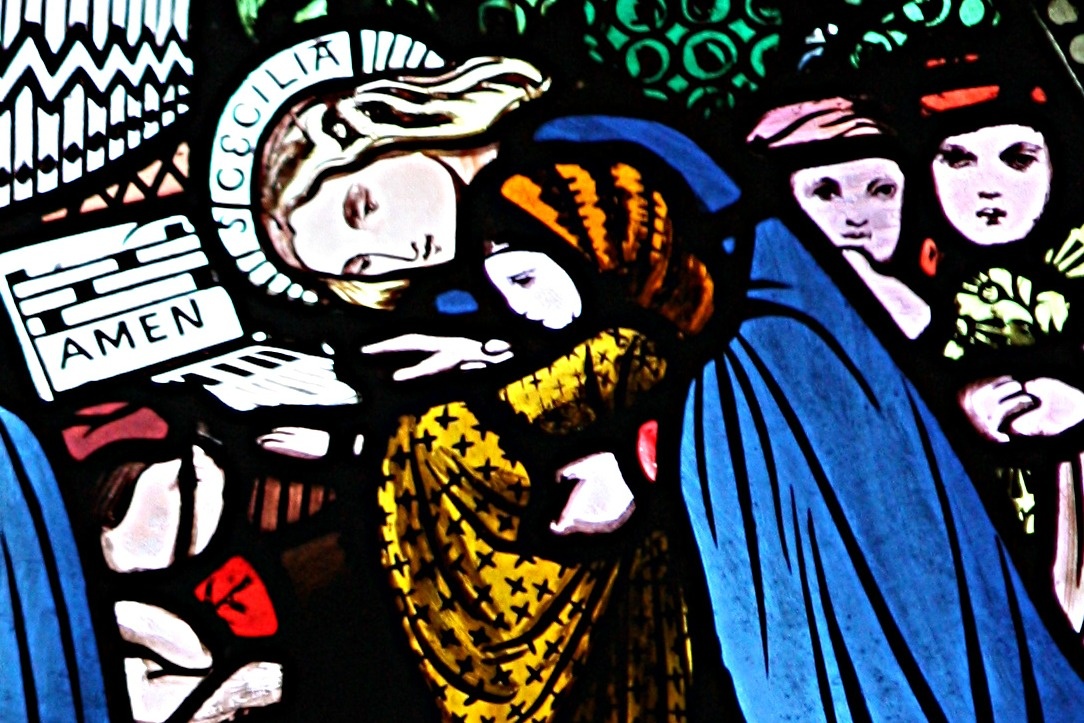Few things impact the celebration of the liturgy more concretely than music. Ask any Mass-goer exiting the church to recap the Gospel and he or she may begin to resemble the proverbial deer in the headlights. However, ask that same person to name any hymn sung during the liturgy and you’re not only more likely to receive an actual answer (or even a serenade), but you’re also likely to receive an opinion on the quality of the liturgical music itself. Music quite literally resonates within the hearts of worshipers in a unique way. Whether vocal or instrumental, music has a power to evoke an intellectual or emotional response that cannot be underestimated; therefore, its role in the overall impact of a liturgical celebration also cannot be underestimated. Music clothes our communal prayer in beauty, allowing us truly to “lift up our hearts” to the Lord in a way that simultaneously expresses our unique humanity and our universal desire for communion with God and one another. Given this reality, the question for parish music directors in the face of such a significant responsibility becomes how best to cultivate an understanding of liturgical music not merely as a means of creating a feel-good liturgical experience, but ultimately of inspiring the worshiping community to greater heights of prayer and praise to God.
There are as many answers to this question as there are parish music directors. I would like to offer one possibility here, in the hopes that it might broaden the way we think about liturgical music in light of the New Evangelization. Indeed, music can be a powerful catalyst in rekindling the spark of faith for those who have grown indifferent, re-engaging those who struggle in the faith, and spurring on those who seek to strengthen their faith. What is important to realize is that the starting point for this process cannot consist of liturgical musicians seeking first and foremost to form their brothers and sisters in the faith; rather than looking outward at the congregation, liturgical musicians must first look inward at their own relationship with God. In order to cultivate a parish life of liturgical music that forms worshipers in the life of the risen Christ, liturgical musicians must first seek to conform themselves to the example of Christ. This claim may seem to be stating the obvious; nevertheless, it is often the most foundational lessons that need the most repetition. As liturgical musicians, we must return to the beginning, and “In the beginning was the Word” (Jn 1:1). In order to inspire an authentic prayer from fellow worshipers, the liturgical musician must first and foremost ensure that he or she offers authentic prayer, and this can only be done if that prayer comes from a heart conformed to Christ, the Incarnate Word of God.
In order to understand what this formation entails, we turn to St. Paul’s hymn in his letter to the Philippians. Paul begins by exhorting his readers: “Have among yourselves the same attitude that is also yours in Christ Jesus” (Phil 2:5), and goes on to give a description of what that attitude is. The beautiful hymn that follows is the primer for the musician who would be an imitator of Christ in his or her ministry. Christ Jesus, “though he was in the form of God, did not regard equality with God something to be grasped. Rather, he emptied himself, taking the form of a slave, coming in human likeness; and found human in appearance, he humbled himself, becoming obedient to death, even death on a cross” (Phil 2:6–8). Jesus emptied himself. He stripped himself of glory. Throughout his public ministry, Jesus alluded to this self-emptying many times: “I do nothing on my own, but I say only what the Father taught me” (Jn 8:28b; see also Jn 4:34 and 14:10b). Jesus embodies that to which all liturgical ministers are called: he seeks not to elevate himself in his ministry, only to make his life a constant prayer by conforming his will to that of the Father in self-giving love—“thy will be done.”
What, then, does this mean for the liturgical musician? Quite simply, it means that, if we seek to imitate Christ in our ministry, we must avoid the temptation to view the musical art merely as a means of self-expression. In such a mindset, liturgical music becomes a means not of praising the triune God; rather, it becomes a hallmark of individual musicians, or even of the local parish community. When this occurs, the music takes center stage, and the rite itself is no longer at the forefront of the liturgical action. Musicians who would thus hijack the liturgy as a personal or communal venue for self-expression place themselves in a position of equality with God, grasping creativity with both hands in a stance that directly contrasts the “attitude” of Christ as described in the Philippians hymn. This is not to say that liturgical music cannot reflect the culture of a worshiping community; it is simply a caveat against using music solely as an expression of the “I” at the expense of praising the “Thou.”
In reality, liturgical music worthy of the name achieves a higher goal. Its beauty is intended not to draw attention to those responsible for its production but to create a space within the heart of him who sings or of her who plays, or of those who hear and join in the song, wherein each can be filled with the grace of God. However, we can only be capacitated to receive this grace if the self has been emptied in a gesture of radical humility imitative of Christ. Cultivating this humility can prove to be incredibly difficult for liturgical musicians: not only does it mean that we must set aside the desire to be recognized for our talents and praised for a job well done, but it also means that at times we must even set aside musical tastes and personal (or communal) preferences in order to discern the most fitting way to sing praise to God. This discernment requires prayerful contemplation of the liturgical rite itself and a courageous examination of the worshiping community’s music in order to determine whether the music serves the rite, or if it’s the other way around. Ultimately, the posture of the liturgical musician must be one of humble service, striving to utilize music in a way that draws attention not to itself or those producing it, but to the Source of all music and all beauty, so that the entire community may offer worship to the Father by joining in Christ’s song of praise through the power and the grace of the Holy Spirit. When the liturgical musician follows the self-emptying example of Christ, the radiance of the triune God will shine through, permeating every facet of his or her ministry, and it is this prayerful authenticity that may in turn inspire others to raise their hearts and voices to God in song.
![]()
Editors’ Note: This article originally appeared in Church Life: A Journal for the New Evangelization, volume 2, issue 1.
Featured Image: Lawrence Lew, OP; CC-BY-NC-ND-2.0.



